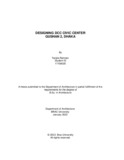| dc.contributor.advisor | Ali, Zainab Faruqui | |
| dc.contributor.advisor | Ahmed, Iftekhar | |
| dc.contributor.advisor | Faruk, Mohammad | |
| dc.contributor.author | Rahman, Tanjila | |
| dc.date.accessioned | 2023-08-09T10:20:11Z | |
| dc.date.available | 2023-08-09T10:20:11Z | |
| dc.date.copyright | 2022 | |
| dc.date.issued | 2022-01 | |
| dc.identifier.other | ID: 17108025 | |
| dc.identifier.uri | http://hdl.handle.net/10361/19376 | |
| dc.description | This thesis is submitted in partial fulfillment of the requirements for the degree of Bachelor of Architecture, 2022. | en_US |
| dc.description | Cataloged from PDF version of thesis. | |
| dc.description | Includes bibliographical references (pages 76-77). | |
| dc.description.abstract | Gulshan, a town founded as a planned model town in 1961 with its own Pourashabha while the
neighboring Banani Model Town was founded in 1964.Gulshan thana was then found in 1972 and
then later absorbed into Dhaka city. The Gulshan city centre only consists of Gulshan, Baridhara
and Banani. The Thana of Gulshan also includes the neighborhood of Mohakhali to the southwest.
Initially, the town was solely built as a private residential area, however, with time passing by,
multiple commercial buildings were constructed in the area to fulfill the needs of the growing
population. Gulshan is now a mix of a serene residential area and also a city center with shopping
malls and commercial buildings. The city developed commercial zones at its central area
containing two market spaces run by the DNCC. Both the market spaces along with the other
commercial zones were hosting high-end restaurants-cafes, headquarters of both national and
international corporate offices, embassies, banks etc. which definitely fulfilled the economic needs
of the upper class citizens of the city but failed to fulfill the needs of the people of other limited
financial backgrounds. So, the Gulshan DNCC market, though built as one of the commercial city
centers, has more to offer to the public in other ways as well. The existing market contains retail
shops, restaurants, cafes, grocery stores, small vendor shops etc. which serves the people of all
economies. But with the rapid growth of population and urbanization, the existing commercial
function is not enough to fulfill the further needs of the residents of this city. Thus the market
space clearly required a new design which will balance both the commercial and public needs of
the people of all economic backgrounds and fulfill the emerging needs of the growing population
of this prominent city center.
Source: link.springer.com
en.wikipedia.org | en_US |
| dc.description.statementofresponsibility | Tanjila Rahman | |
| dc.format.extent | 77 pages | |
| dc.language.iso | en | en_US |
| dc.publisher | Brac University | en_US |
| dc.rights | Brac University theses are protected by copyright. They may be viewed from this source for any purpose, but reproduction or distribution in any format is prohibited without written permission. | |
| dc.subject | Civic Center | en_US |
| dc.subject | DCC Market | en_US |
| dc.subject | Multipurpose building | en_US |
| dc.subject.lcsh | Civic centers--Designs and plans. | |
| dc.title | Designing DCC civic center, Gulshan 2, Dhaka | en_US |
| dc.type | Thesis | en_US |
| dc.contributor.department | Department of Architecture, Brac University | |
| dc.description.degree | B. Architecture | |

